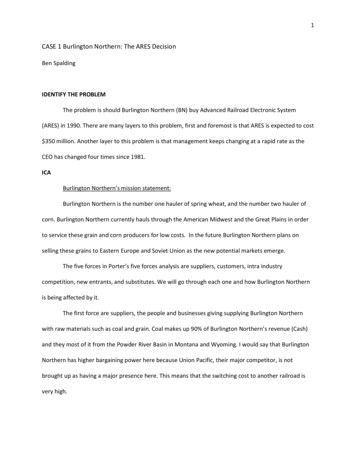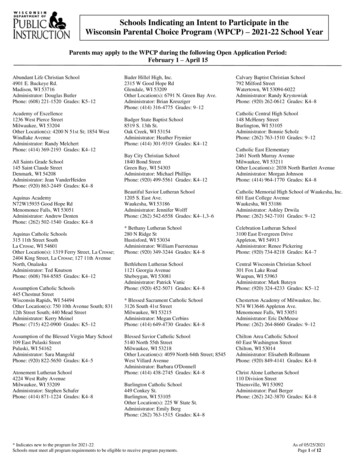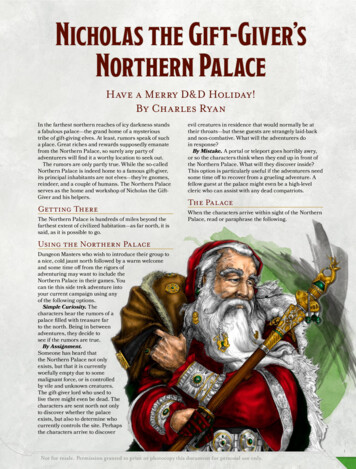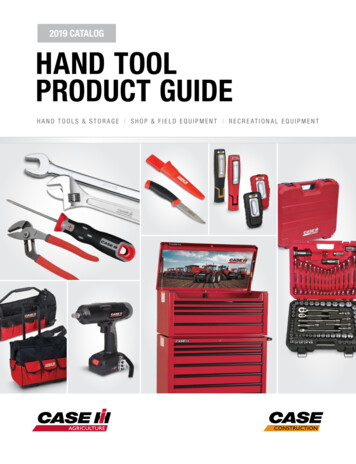
Transcription
1CASE 1 Burlington Northern: The ARES DecisionBen SpaldingIDENTIFY THE PROBLEMThe problem is should Burlington Northern (BN) buy Advanced Railroad Electronic System(ARES) in 1990. There are many layers to this problem, first and foremost is that ARES is expected to cost 350 million. Another layer to this problem is that management keeps changing at a rapid rate as theCEO has changed four times since 1981.ICABurlington Northern’s mission statement:Burlington Northern is the number one hauler of spring wheat, and the number two hauler ofcorn. Burlington Northern currently hauls through the American Midwest and the Great Plains in orderto service these grain and corn producers for low costs. In the future Burlington Northern plans onselling these grains to Eastern Europe and Soviet Union as the new potential markets emerge.The five forces in Porter’s five forces analysis are suppliers, customers, intra industrycompetition, new entrants, and substitutes. We will go through each one and how Burlington Northernis being affected by it.The first force are suppliers, the people and businesses giving supplying Burlington Northernwith raw materials such as coal and grain. Coal makes up 90% of Burlington Northern’s revenue (Cash)and they most of it from the Powder River Basin in Montana and Wyoming. I would say that BurlingtonNorthern has higher bargaining power here because Union Pacific, their major competitor, is notbrought up as having a major presence here. This means that the switching cost to another railroad isvery high.
2Burlington Northern’s other major income, grains, come from farmers. They have littlecompetition from trucks in this industry because grain is a bulk commodity business. Unfortunately,demand for when grains could be delivered was more random than coal because the time to harvestchanges annually, in addition to the high variability in export demand. Farmers tend to go for whoeverwould deliver for the lowest price. All of these factors mean that farmers have more control innegotiations with Burlington Northern.The second force are customers, the people and businesses buying Burlington Northern’sservices. In this case it overlaps a little with the first because some customers let Burlington Northerntrain cars, in particular for coal. In long term contracts, Burlington Northern would deliver them coal andthe customer would let them use train cars. As a result of this, Burlington Northern became moreinterested in increasing cycle time and not arrival time, to the point where “.coal could be dumpedwithout waiting for special unloading facilities or warehouse space.” (Cash) This is becoming problematicas customers are realizing the benefits of JIT delivery. I believe that they do not have bargaining powerfor most customers as they can switch to Union Pacific or another railroad service.Although they are doing very well with their chemical business, outstandingly so. Dick Lewis,vice president of strategic planning, said “We reduced the average delivery time by half, and we alsoreduce the variability of the delivery time. The shipper also found he could get rid of 100 rail cars.”(Cash) This sounds like they have greatly increased the switching cost of this particular customerbecause they are doing so well, however on the whole Burlington Northern does not have very strongbargaining power with its customers.The third force that Porter talks about in his model is intra industry competition you want toweaken your competition. Burlington Northern’s main competition is Union Pacific. Union Pacific hasput serious investments towards: heavy duty double track and fuel-efficient engines for carrying coal.Burlington Northern’s management also believes that Union Pacific had been running excess capacity
3while Burlington Northern was close to capacity (Cash). All of this sounds like Union Pacific is weakeningBurlington Northern.The fourth force is new entrants and what we want to do to new entrants is to create a highbarrier for entry. To enter the railroad market requires prohibitively high amounts of capital to getstarted so the barrier is already erect.The fifth force that Porter talks about is substitutes and there is nothing we can do about those.The substitute in this case are trucks as they provide a more timely delivery at a more expensive priceand lower throughput. Trucking had a hard time getting a foothold until Motor Carrier Act of 1980 thatgave truckers more freedom in setting rates and entering markets. This put trucks on a more evenplaying field because as more customers are realizing the benefits of JIT delivery, the volume ofdeliveries that trains offer might become irrelevant and there is nothing that can be done about that.StakeholdersStakeholders are any organization, person, group of people that are invested in an organization,and organization's need to respond to them. According to Ludwig von Bertalanffy’s open systemapproach, “.organizations, like organisms, are ‘open’ to their environment and must achieve anappropriate relation with that environment if they are to survive.” (Morgan, 2006) This is importantwhen discussing Burlington Northern because they have many stakeholders and if they want to have aclear idea of where to head next, they must understand their environment. Gerald Grinstein, CEO 1989 Jack Bell, CFO Bill Greenwood, COO Joe Galassi, Executive Vice President, Operations John Anderson, Executive Vice President for Marketing and Sales
4 Burlington Northern Senior Executives BN Senior Management Jim Dagnon, Senior Vice President of Labor Relations Brock Strom, Vice President of Information System Services Dick Lewis, Vice President of Strategic Planning, 1990 Mark Cane, Vice President of Service Design Burlington Northern Railroad Operations Department(headed in Overland Park, KS)oTrain dispatchers, operators, supervisorsoManaged support functions Information System Services Research and Development Department Research and Development Steering CommitteeoSenior officers of Transportation, Engineering, Mechanical, Operations Service,Marketing, and Information SystemsoKeep R&D from catering too much to one department Board of Directors Burlington Northern Managers Operations Personnel Conductors Dispatchers Maintenance-of-Way Crew (MOW crew) Engine Crew Investors
5 Grain Farmers Community of Powder River Basin Customers Ed Butt, ARES Project Director Steve Ditmeyer, Chief Engineer, Research, Communications, and Control Systems Don Henderson,oChosen to oversee formation of ARES team to manage the project’s development Strategic Decisions Group Rockwell International, Collins Transport DivisionoBy 1989, Burlington Northern has spent 15 million on ARES, Rockwell has expected tohave spent three times (Cash) Burlington Resources Inc. T. Boone Pickenso Union Pacifico Started to purchase Burlington Northern in 1987 (Cash)Burlington Northern’s major competitorAssociation of American RailroadsoDeveloping ATCSIdentify AlternativesI have identified 3 alternatives that Burlington Northern can act on and I will describe thebenefits of each one. The first is to do nothing, the second is buy ARES, and the third is to look for abuyer for Burlington Northern.
6The first option, do nothing, means to not buy ARES and continue to payback your debt the wayyou have been. The second option, buy ARES means that you should spend the 350 million to acquireARES and become a leader in the industry. The third option, look for a buyer for Burlington Northern,means to find someone to buy the company like T. Boone Pickens.Look for a BuyerBurlington Northern should look for a buyer because they have no money. This is because theyestimated that it would take them six years to go from a 76% debt-to-total capital ratio to 50% debt-tototal capital ratio, which is too slow and Burlington Northern needs to find someone to buy them.“Under the influence of interpretations of evolution that emphasize survival of the fittest, competition isoften encouraged ” (Morgan, 2006) The reason this is a good idea is because Burlington Northernalready has T. Boone Pickens beginning to buy their stock and their high debt-to-total capital ratioamong shows this. The reason that six years is too slow is because while Burlington Northern is payingback its debt, Union Pacific is moving towards their goal, and according to Goldratt, “The goal of everymanufacturing organization is to make money.” (Goldratt & Cox, 1984)The reason that Burlington Northern should not buy ARES, despite the boost to safety,efficiency, and that it is five years ahead of ATCS, is that they do not have 350 million to spend onARES. Burlington Northern is currently focused on paying back debt and buying ARES would make thecompany go bankrupt. Another reason they should not buy ARES is because it is not productive which isdefined as, “Every action that brings a company closer to its goal is productive. Every action that doesnot bring a company closer is not productive.” (Goldratt & Cox, 1984)Another reason that ARES should not be purchased because it increases operating expenseswithout increasing throughput. “The goal is to reduce operating expense and reduce inventory whilesimultaneously increasing throughput.” (Goldratt & Cox, 1984) We can treat ARES as an operating
7expense, which are defined as, “ the money the system spends in order to turn inventory intothroughput.” (Goldratt & Cox, 1984) This means that it goes against the goal.Burlington Northern should not do nothing because after they recover to 50% debt-to-totalcapital ratio, they will be lagging behind everyone else and have no momentum. The reason for this isBurlington Northern is dedicating all resources to paying back debt. To put it in perspective, UnionPacific will spend six years expanding and improving infrastructure alongside gaining and maintaining acompetitive advantage. Burlington Northern will be afloat after six years and because of this reason, donothing is not a recommended alternative.
8BibliographyCash. (n.d.). Building the Information Age Organization.Goldratt, E. M., & Cox, J. (1984). The Goal: A Process of Ongoing Improvement. Great Barrington: TheNorth River Press Publishing Company.Morgan, G. (2006). Images of Organization. (M. Vail, Ed.) Thousand Oaks, California, United States ofAmerica: Sage Publications.
CASE 1 Burlington Northern: The ARES Decision Ben Spalding IDENTIFY THE PROBLEM The problem is should Burlington Northern (BN) buy Advanced Railroad Electronic System (ARES) in 1990. There are many lay










